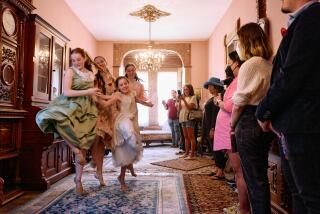DANCE REVIEW : Children Shine Despite Story That’s Truly Terrible : Performance: Not even the talent and enthusiasm of the young dancers could overcome the tangled and disturbing mess of ‘The Terrible Tale of Ringmaster Twigg.’
- Share via
SAN DIEGO — Theater in San Diego has a national reputation. But dance struggles.
To relieve that struggle, the San Diego Foundation for the Performing Arts created CityMoves, an annual project that takes dance to the schools and community and gives hundreds of young people an opportunity to dance that they would not otherwise have.
CityMoves ostensibly will develop performers and build audiences and much-needed dance patronage.
After two years of planning and nine months of rehearsals, CityMoves made its debut at the San Diego Convention Center over the weekend with five performances of the dance-theater production of “The Terrible Tale of Ringmaster Twigg.”
Note the compound adjective “dance-theater.”
From a dance perspective, or more precisely a dance-education perspective, the efforts of the San Diego dance professionals contracted by the CityMoves project paid off. The children, romping, dancing and tumbling in colorful costumes, truly seemed to enjoy their part in the production.
But “The Terrible Tale of Ringmaster Twigg” was indeed a terrible tale. From a theatrical perspective it was abysmal, even disturbing. It’s hard to imagine that the children--of all ages--in the audience Friday evening who were not dancing could have enjoyed the over two-hour ordeal they witnessed without a break.
And it’s hard to imagine that parents appreciated the predominance of psychopathology in the story they and their children either watched or participated in.
Although Bill Conrow, who wrote and directed “Ringmaster Twigg,” enlisted the services of numerous choreographers and dance teachers, he appears to have overlooked the talent of San Diego’s theater professionals in developing his dance-theater creation. And the Foundation for Performing Arts, which hired Conrow, promoted CityMoves as an outreach program for dance, apparently ignoring the theatrical aspect. This is a huge blind spot.
As a storytelling device for dance, Conrow’s “Twigg” is unnecessarily long and convoluted. Unraveled, the synopsis goes something like this: A circus ringmaster hates children because his wife died in childbirth. His bitterness turns diabolical--he uses a “mesmerizing machine” to hypnotize parents into buying back their children at great expense once he has turned the children into dolls. Tonya, Twigg’s sister-in-law and a Gypsy fortune-teller, is aware of his madness, but unable to stop him. Her husband, Basil, is Twigg’s “crazy” brother. Under Twigg’s spell he lives in the local haunted house. Also under Twigg’s spell are old friends he has turned into half-animals--characters named Pigsfeet, Pooch, Tigressa, Bull, and others--who do his bidding.
Orphans who have slipped out of the local orphanage see what Twigg is up to. A brave one, Tina, who turns out to be Twigg’s child, works with Tonya and rallies others to fight Twigg’s efforts. The orphans are captured except for Tina. She puts some of Tonya’s ill-stomach potion into the circus camp’s wine barrel. Pretty soon everyone is sick. Eventually, Twigg is undone. Interspersed throughout Twigg’s bluster and the characters’ driveling exposition needed to explain the plot, were the 16 dances, most of which were fun-filled. Patrick Nollet’s choreography for “The Tazmirian Ballet” and Melissa Cottle’s for “The Haunted House Dance” stood out.
For different reasons, three dances should have been cut. Eight- to 9-year-old girls vamping as sex objects in gold lame leotards, boas, and heels is not funny. A man being whipped (mimed with sound effects) by a circle of Twigg’s “men” (actually boys) was sadistic. And a dance in which “goblins” try to catch the moon had nothing to do with the circus story and added to an already excruciatingly long program. These last two dancers were Conrow’s choreography.
Grief appears to be the sole cause of Twigg’s cruel behavior--a questionable contention on which to structure a dense and nearly Baroque story line for children. “Ringmaster Twigg” had no distinct climax, nor was there a believable resolution. Action sags constantly from the need to explain the plot and from poor staging. The good versus evil conflict lacked tension, because the “good” element, portrayed by the orphans, notably Tina (wonderfully acted by Samantha Becket) was on the sidelines and difficult to follow. Consequently, the “evil” was overwhelming in the nightmarish, numbing, tyrannical and humorless world of Twigg. Patrick Nollet, who performed the role, did an admirable job considering the script.
Assuming the participants and sponsors of CityMoves intend to continue presenting what is taught to schoolchildren, dance is what should be performed. The rest--the theatrical half of its “dance-theater” effort--needs serious, objective and unmesmerized scrutiny. Otherwise, the struggle for dance in San Diego may remain just that.
More to Read
The biggest entertainment stories
Get our big stories about Hollywood, film, television, music, arts, culture and more right in your inbox as soon as they publish.
You may occasionally receive promotional content from the Los Angeles Times.










